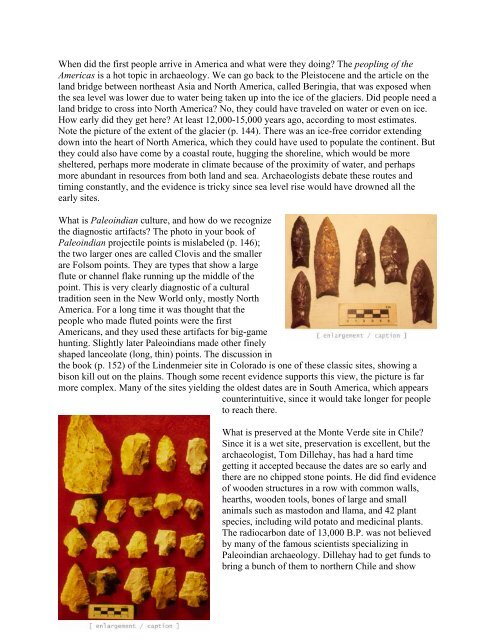INTRODUCTION TO ARCHAEOLOGY Nancy White - Touro Institute
INTRODUCTION TO ARCHAEOLOGY Nancy White - Touro Institute
INTRODUCTION TO ARCHAEOLOGY Nancy White - Touro Institute
You also want an ePaper? Increase the reach of your titles
YUMPU automatically turns print PDFs into web optimized ePapers that Google loves.
When did the first people arrive in America and what were they doing? The peopling of the<br />
Americas is a hot topic in archaeology. We can go back to the Pleistocene and the article on the<br />
land bridge between northeast Asia and North America, called Beringia, that was exposed when<br />
the sea level was lower due to water being taken up into the ice of the glaciers. Did people need a<br />
land bridge to cross into North America? No, they could have traveled on water or even on ice.<br />
How early did they get here? At least 12,000-15,000 years ago, according to most estimates.<br />
Note the picture of the extent of the glacier (p. 144). There was an ice-free corridor extending<br />
down into the heart of North America, which they could have used to populate the continent. But<br />
they could also have come by a coastal route, hugging the shoreline, which would be more<br />
sheltered, perhaps more moderate in climate because of the proximity of water, and perhaps<br />
more abundant in resources from both land and sea. Archaeologists debate these routes and<br />
timing constantly, and the evidence is tricky since sea level rise would have drowned all the<br />
early sites.<br />
What is Paleoindian culture, and how do we recognize<br />
the diagnostic artifacts? The photo in your book of<br />
Paleoindian projectile points is mislabeled (p. 146);<br />
the two larger ones are called Clovis and the smaller<br />
are Folsom points. They are types that show a large<br />
flute or channel flake running up the middle of the<br />
point. This is very clearly diagnostic of a cultural<br />
tradition seen in the New World only, mostly North<br />
America. For a long time it was thought that the<br />
people who made fluted points were the first<br />
Americans, and they used these artifacts for big-game<br />
hunting. Slightly later Paleoindians made other finely<br />
shaped lanceolate (long, thin) points. The discussion in<br />
the book (p. 152) of the Lindenmeier site in Colorado is one of these classic sites, showing a<br />
bison kill out on the plains. Though some recent evidence supports this view, the picture is far<br />
more complex. Many of the sites yielding the oldest dates are in South America, which appears<br />
counterintuitive, since it would take longer for people<br />
to reach there.<br />
What is preserved at the Monte Verde site in Chile?<br />
Since it is a wet site, preservation is excellent, but the<br />
archaeologist, Tom Dillehay, has had a hard time<br />
getting it accepted because the dates are so early and<br />
there are no chipped stone points. He did find evidence<br />
of wooden structures in a row with common walls,<br />
hearths, wooden tools, bones of large and small<br />
animals such as mastodon and llama, and 42 plant<br />
species, including wild potato and medicinal plants.<br />
The radiocarbon date of 13,000 B.P. was not believed<br />
by many of the famous scientists specializing in<br />
Paleoindian archaeology. Dillehay had to get funds to<br />
bring a bunch of them to northern Chile and show
















